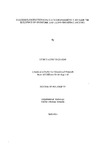Children's production of locative expressions in English : the influence of geometric and extra-geometric factors
| dc.contributor.author | Richards, Lynn Valerie | |
| dc.contributor.other | Faculty of Science and Engineering | en_US |
| dc.date.accessioned | 2011-05-13T10:10:20Z | |
| dc.date.available | 2011-05-13T10:10:20Z | |
| dc.date.issued | 2001 | |
| dc.identifier | not available | en_US |
| dc.identifier.uri | http://hdl.handle.net/10026.1/456 | |
| dc.description.abstract |
The research in this thesis examines the influence that both geometric and extrageometric factors have on children's spatial language production. Over the years it has widely been assumed that spatial prepositions identif' where objects are in the world (geometric factors) and that this is reflected in the semantic representations of these words. More recently, researchers investigating the lexical semantics of spatial prepositions have begun to question this assumption by demonstrating that what objects are and how they are interacting can also affect the way we describe where they are in the world (extra-geometric factors). Following on from research conducted with adults that has demonstrated the importance of both of these factors on spatial language, the main aim of this thesis was to ascertain for the first time whether these factors also influenced children's spatial language production, and if so, when they became important in children's development of spatial expressions. Additionally, due to the paucity of research investigating the production of spatial terms, the Experiments reported in this theis set out to redress the balance. The research in this thesis demonstrated for the first time that both geometric and extra geometric factors influence the production of children's spatial expressions from an early age. In doing so, however, the Experiments reported here were not necessarily revealing as to the nature of the semantic representation of spatial terms, rather they highlighted a different issue; how people make distinctions during a verbal interaction. Evidence is presented that suggests a level of agreement between people regarding the nonconventional use of words. In order to distinguish between functional and non-functional situations, both adults and children used different types of spatial terms to locate an object even when they had a limited number of words in their lexicon. An approach to the whole process of prepositional production is suggested rather than concentrating on what is represented in an individual's lexicon. | en_US |
| dc.language.iso | en | en_US |
| dc.publisher | University of Plymouth | en_US |
| dc.subject | Spatial prepositions | |
| dc.subject | Psychology | |
| dc.subject | Linguistics | |
| dc.subject | Education | |
| dc.subject | Psycholinguistics | en_US |
| dc.title | Children's production of locative expressions in English : the influence of geometric and extra-geometric factors | en_US |
| dc.type | Thesis | |
| dc.identifier.doi | http://dx.doi.org/10.24382/3304 |
Files in this item
This item appears in the following Collection(s)
-
01 Research Theses Main Collection
Research Theses Main


